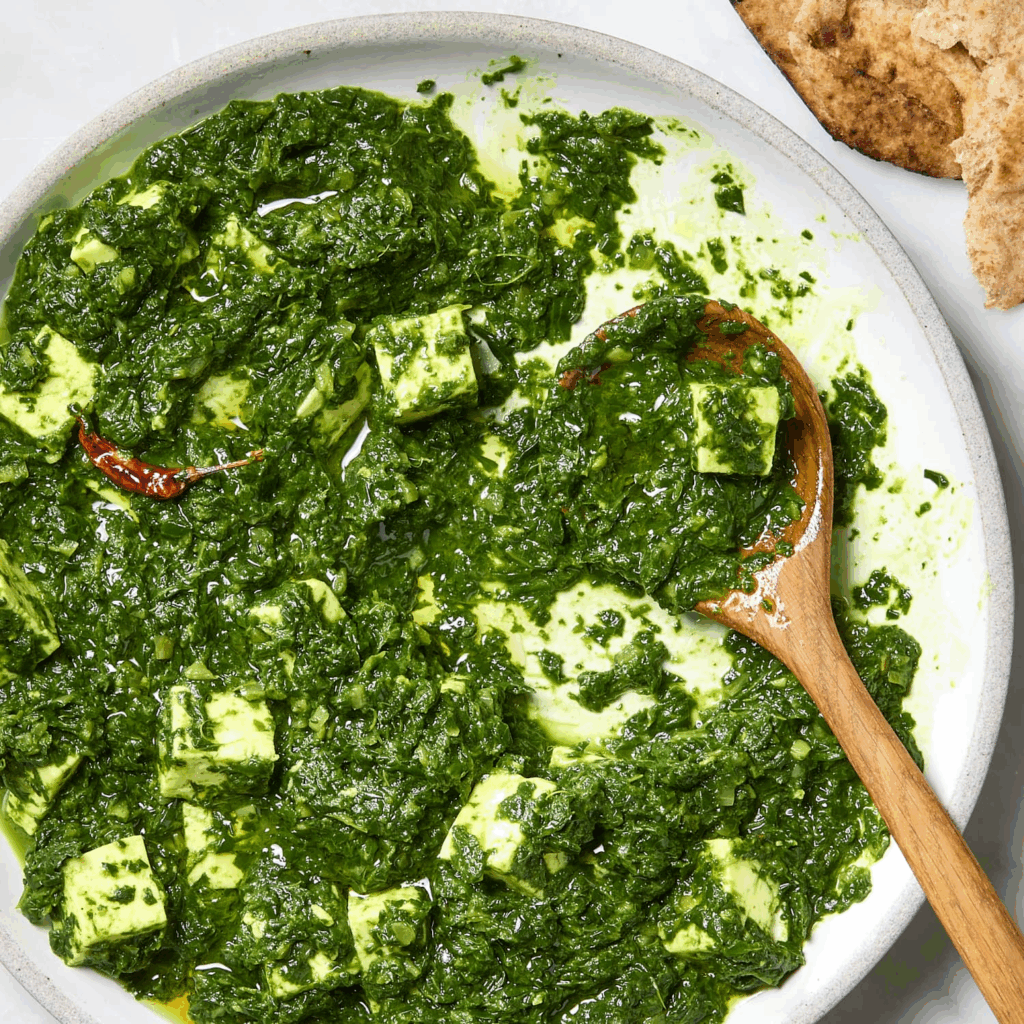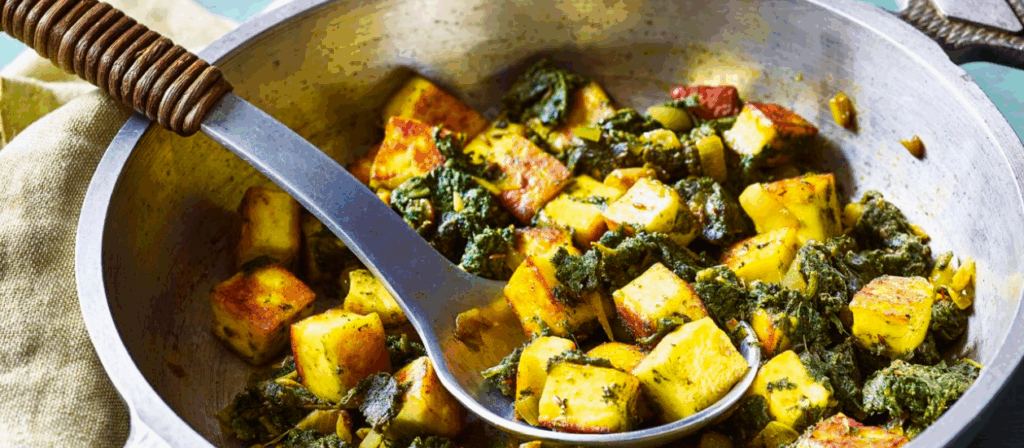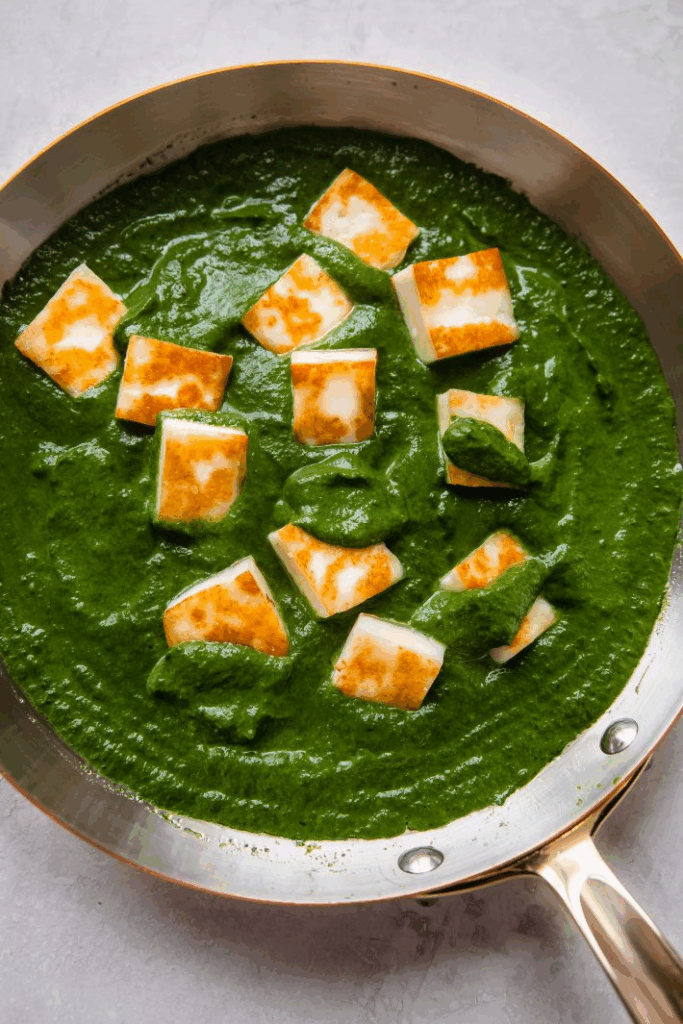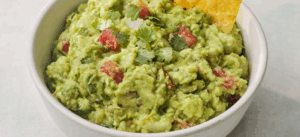Saag Paneer Recipe with Fresh Spinach – My Chef’s Guide to Rich, Creamy Comfort

This guide is built from my own kitchen experience. I’ll walk you through fresh spinach prep, my favorite spice layering tricks, and how to adapt Saag Paneer for ovens, slow cookers, or quick microwave meals—without losing that deep, soulful flavor.
- What Saag Paneer Really Is (and Isn’t)
- How I Prep Fresh Spinach for the Silkiest Saag
- Time and Method Breakdown for Saag Paneer
- Spice Layering: How I Build Saag’s Deep Flavor
- Frying Paneer Without Drying It Out
- Regional Takes on Saag Paneer I’ve Cooked
- What I Serve With Saag Paneer (Balanced Meal Pairings)
- How I Store and Reheat Saag Paneer Without Losing Flavor
- Creative Ingredient Swaps I’ve Tried That Work
- My Modern Saag Paneer Twists for Today’s Tables
- Time Planning for Cooking Saag Paneer at Home
- Plating and Presentation Tips for Saag Paneer
- Cultural Roots and Global Evolution of Saag Paneer
- Dish Pairings That Complement Saag Paneer
- FAQ – Real Kitchen Questions About Saag Paneer

What Saag Paneer Really Is (and Isn’t)
Saag Paneer is often confused with Palak Paneer, but they’re not the same—though closely related. Saag, in Punjabi, refers to any leafy greens, often a mix: mustard greens, spinach, fenugreek, even radish leaves. But in this guide, we’ll focus on the most accessible version using fresh spinach, which gives a mellow, velvety texture.
Paneer, of course, is the soft, milky Indian cheese that holds shape even when fried. It doesn’t melt. When simmered in saag, it soaks up the spices and becomes the perfect creamy bite.
Some versions use cream or yogurt, others keep it rustic with just a finishing swirl of ghee. My version sits between the two—comforting, aromatic, with a gentle heat that builds over each spoonful.
How I Prep Fresh Spinach for the Silkiest Saag
There’s no shortcut when it comes to prepping greens—especially spinach. I always start with young, fresh bunch spinach, not baby spinach or frozen. I wash it in three changes of water, making sure all the grit is gone. Sand in saag ruins everything.
Once cleaned, I blanch the spinach in boiling water for about 30 seconds. Just enough to wilt. Then I shock it in ice water to preserve that deep emerald green. I drain and squeeze it gently, then puree it either coarse or smooth depending on the mood. For rustic texture, I use a food processor and leave some leaf structure; for a smooth finish, a blender works best.
From my experience, sautéing the spinach after blending helps remove the raw grassy taste. I always cook it down with a spoon of ghee, cumin, garlic, and green chili before adding anything else.

Time and Method Breakdown for Saag Paneer
| Cooking Method | Prep Time | Cook Time | Total Time | Texture Result | Notes |
| Stovetop Skillet | 10 min | 25–30 min | ~40 min | Soft, creamy, layered | Most traditional and flavor-packed |
| Oven-Baked | 10 min | 40–45 min | ~55 min | Roasty paneer, mellow saag | Great for large batch, less stirring needed |
| Slow Cooker | 10 min | 3–4 hrs | ~3.5–4.5 hrs | Rich and mellow | Requires sautéed tadka for proper finish |
| Microwave (covered) | 10 min | 12–15 min | ~25 min | Mild, less depth | Fast, good for leftovers or work lunches |
| Instant Pot | 10 min | 4 min | ~20 min | Uniform and well-integrated | Quick, but overcooking risk if not careful |
Personally, I use the stovetop when I want full spice bloom, and the slow cooker when prepping meals ahead. For single servings, microwave works if I finish with ghee and garam masala.
Spice Layering: How I Build Saag’s Deep Flavor
If there’s one thing I’ve learned after years of Indian cooking, it’s that spices aren’t just about heat—they’re about structure. Saag Paneer has a soft, creamy base, so it needs warmth, not fire.
I begin with a tadka, a tempering of cumin seeds in ghee. Once they sizzle, I add finely chopped onions, letting them caramelize gently. This gives the saag a sweet, toasty undertone. Then comes the garlic and ginger—both fresh, not paste. I let them soften and release their oils slowly.
Only then do I stir in ground spices: coriander, turmeric, and a tiny pinch of red chili powder. I don’t overdo the chili—it’s not a vindaloo. Just enough to keep your palate curious.
A spoonful of garam masala goes in right before I turn off the heat. This preserves its aroma. Sometimes I finish with a splash of lemon or yogurt for balance.
This sequence of cooking makes the flavor build in layers, not come all at once. It’s the difference between “spicy” and “soulful.”

Frying Paneer Without Drying It Out
Fried paneer is iconic—but dry, rubbery paneer is the quickest way to ruin this dish. I’ve worked in restaurants where we pre-fried dozens of cubes ahead of dinner service. I’ve also tested dozens of home-style methods. Here’s what I do now.
I start by cutting paneer into ¾-inch cubes. I soak them in warm salted water for 10 minutes to soften them if they’re store-bought and too firm.
Then I heat ghee in a nonstick or cast-iron pan and shallow-fry the cubes until golden on two sides. Not all over—just enough for texture. Constant turning dries them out. Once golden, I remove and drop them into hot water for 1 minute, then drain. This keeps the crust but restores interior softness.
Only at the very end do I add the fried paneer to the simmering saag. This lets them soak just enough of the gravy without disintegrating.
For a lighter version, I’ve sometimes grilled paneer or used it raw—and both work, depending on your final texture goals.
Regional Takes on Saag Paneer I’ve Cooked
Though Saag Paneer is most closely linked with Punjab, I’ve made regional tweaks depending on the event or guests. Each one adds a new lens to this classic dish.
- Punjabi style is the gold standard. Rich ghee tadka, mustard-spinach mix, and strong flavors. This is the version I teach students first.
- Bengali-influenced saag includes a pinch of panch phoron (five-spice) in the tadka, and sometimes a green chili-mustard paste for extra tang. I pair this with rice.
- South Indian versions swap ghee for coconut oil and add curry leaves, even grated coconut. I’ve cooked this version for fusion thali platters.
- UK-style saag leans heavier on cream and garlic. Many restaurants even purée the whole dish super smooth and serve it in ramekins. It’s not my favorite, but it’s comforting and crowd-pleasing.
Regional style should match what you serve it with. For instance, pairing with How to cook Aloo Gobi the Indian way works best if you lean North Indian.
What I Serve With Saag Paneer (Balanced Meal Pairings)
I think of Saag Paneer as a middle anchor—rich, creamy, not too spicy—so it needs lighter grains, crispy sides, and bright chutneys to shine.
My go-to base is jeera rice or basmati steamed rice. The fragrance complements the saag perfectly. If I’m serving a richer meal, I go with a light ajwain chapati instead.
When I want a full Indian plate, I often pair Saag Paneer with:
- Homemade Dal Tadka for added protein and contrasting texture
- A dry vegetable sabzi like sautéed green beans or cabbage
- Kachumber salad (onion, cucumber, tomato) for freshness
- Mango pickle or mint chutney for a burst of acid
And if I’m building a more festive table, I sometimes bring in a bold meat dish like What is Rogan Josh and how to make it at home. Its deep red curry and tender lamb pair beautifully with the green, earthy notes of saag.

How I Store and Reheat Saag Paneer Without Losing Flavor
From my experience, Saag Paneer actually tastes better the next day—but only if stored properly. I always let it cool completely before transferring to a glass or BPA-free airtight container. The key is to avoid trapping steam, which can make the saag watery and bland.
In the fridge, it holds well for up to 3 days. When reheating, I prefer the stovetop with a touch of ghee and a splash of water. I warm it slowly over medium heat until it starts bubbling gently—then I add a dash of garam masala and a few fresh coriander leaves for brightness.
Microwaving works too, but I cover the dish and stir halfway through. If the paneer is already mixed in, I reheat gently—overcooked paneer becomes chewy fast.
I don’t freeze saag with paneer in it. The texture suffers. But if you want to make it in advance, freeze the spinach base separately and add fresh paneer upon reheating.
Creative Ingredient Swaps I’ve Tried That Work
There have been times—especially at retreats or private events—when I had to improvise without traditional ingredients. On those occasions, I discovered a few substitutions that actually add personality to the dish.
Instead of paneer, I’ve used tofu, especially firm varieties. I press and marinate them in turmeric and lemon juice, then pan-fry for crisp edges. Works well for vegan versions.
No fresh spinach? I’ve made beautiful batches with collard greens, kale, or Swiss chard. These take a little longer to soften but give a deeper, slightly bitter profile that works surprisingly well.
For spice-light eaters, I swap green chili with jalapeño or even a pinch of smoked paprika. It gives a gentle heat and more complexity.
And when cooking for kids or cream-lovers, I fold in a spoon of Greek yogurt at the end. It makes the dish rounder and more indulgent without being heavy.
My Modern Saag Paneer Twists for Today’s Tables
As a chef, I enjoy honoring traditional roots while exploring new formats. Saag Paneer lends itself beautifully to innovation without losing soul.
One version I make for brunch is a Saag Paneer Shakshuka—I crack eggs into bubbling saag and bake it in the oven until just set. It’s always a hit with crusty bread.
At a recent wedding tasting, I served saag-stuffed savory éclairs topped with tiny fried paneer cubes and edible flowers. It was a fusion showstopper.
For lunch menus, I layer saag and rice in jars, add grilled paneer cubes, and top it with pickled onions. Instant portable comfort food.
I’ve even served saag paneer wraps—folding the warm mix into grilled naan with tamarind chutney and arugula. They fly off the tray every time.
Saag, when respected, becomes a canvas. And that’s where the fun begins.
Time Planning for Cooking Saag Paneer at Home
| Task | Time Estimate | Notes |
| Washing and prepping spinach | 10 minutes | Triple-rinse, remove stems if thick |
| Blanching and shocking | 5 minutes | Quick blanch, ice bath ensures color and preserves nutrients |
| Puréeing spinach | 3 minutes | Coarse for rustic, smooth for elegant finish |
| Preparing tadka (spices) | 7–8 minutes | Onions, garlic, ginger, and whole + ground spices in sequence |
| Cooking spinach base | 10–12 minutes | Until deep green, slightly thickened |
| Frying paneer | 8–10 minutes | Golden brown, then hot-water soak to stay soft |
| Final simmer with paneer | 5 minutes | Just enough for flavors to combine without overcooking |
| Garnishing and plating | 2 minutes | Coriander, lemon juice, or cream if desired |
Total estimated active time: ~45–50 minutes, depending on batch size and prep skill.
For first-timers, I always suggest setting aside an uninterrupted hour.
Plating and Presentation Tips for Saag Paneer
Presentation matters—even for comfort food. When I plate Saag Paneer at home or in restaurants, I keep one thing in mind: contrast and texture.
For a family-style table, I serve it in a shallow clay or brass bowl, topped with a swirl of ghee and a pinch of red chili flakes. A few seared paneer cubes on top—not mixed in—create visual appeal.
If I’m building a plated thali, I use a ring mold to place a small mound of jeera rice next to the saag. I spoon the saag beside it with a dollop of plain yogurt or raita for color contrast. A sprig of cilantro finishes the look.
Modern-style plating? I once layered crispy naan chips on the bottom, ladled silky saag on top, and finished with charred paneer cubes and pomegranate seeds. It looked like something off a New York fusion tasting menu.
Cultural Roots and Global Evolution of Saag Paneer
Saag Paneer, while deeply Indian, has found a global stage. I’ve seen it served in London curry houses, LA vegan cafés, and even French bistros—each with its twist.
What makes it adaptable is its balance of comfort and character. The creamy texture, rich flavors, and soft heat make it both familiar and exotic.
In Punjab, it’s often made with mustard greens, served during winter harvest festivals. In urban India, fresh spinach has become the go-to green for convenience. Abroad, chefs adapt it to local produce and preferences.
One thing I’ve learned: wherever you go, when you bring Saag Paneer to the table, it becomes a story of warmth. And that’s the essence of Indian food—shared, grounding, and endlessly evolving.
Dish Pairings That Complement Saag Paneer
Saag Paneer pairs beautifully with dishes that offer texture contrast, complementary spice levels, or bright acidic counterpoints.
On classic thali-style plates, I often pair it with:
- What is Rogan Josh and how to make it at home – the deep lamb curry balances the soft green saag with intensity and aroma (вставить ссылку)
- Fresh cucumber-onion salad or a grated carrot koshimbir
- Jeera rice or warm chapati with ghee
- A dry, spiced sabzi like cabbage-peas or aloo methi
- A cooling lassi or salted buttermilk on the side
If I’m doing a contemporary fusion brunch, I serve Saag Paneer alongside baked eggs or inside a stuffed croissant for a twist on Florentine flavors.
FAQ – Real Kitchen Questions About Saag Paneer
What’s the difference between Saag Paneer and Palak Paneer?
In my kitchen, palak paneer is strictly made with spinach, while saag can include mustard greens, methi, or a mix. The flavor profile of saag is deeper and more rustic.
Can I make this dish vegan?
Yes, and I’ve done it many times. Swap paneer with firm tofu and use oil instead of ghee. Add a little cashew cream at the end for richness.
What’s the best spinach to use?
From my experience, mature bunch spinach works better than baby spinach—it gives more body and flavor after blending.
How do I avoid bitterness in the greens?
Don’t overcook. Also, sauté the puréed greens with garlic and ghee before adding spices—that tames any rawness or bitterness.
Can I skip the blanching step?
I wouldn’t. I’ve tested it both ways, and blanching not only preserves color but also removes the metallic taste from raw spinach.
How do I keep the paneer soft after frying?
Soak it briefly in hot water after frying. I do this in restaurant prep constantly—it works like a charm.
Can I add cream to make it richer?
Absolutely. I’ve stirred in a spoonful of cream or Greek yogurt at the end. Just don’t boil it after adding dairy.
Why does my saag look dull after cooking?
Overcooking or skipping the ice bath after blanching will do that. I always shock the spinach in ice water—it locks in the vibrant green.
What oils work best if I don’t use ghee?
Neutral oils like avocado or grapeseed oil work fine. I’ve also used mustard oil in Punjabi-style versions for extra aroma.
Can I prep Saag Paneer ahead for a party?
Definitely. I often make the saag base 1–2 days ahead and fry the paneer fresh on the day. It’s very forgiving.
Is this dish spicy?
Not inherently. I adjust the chili level depending on the audience. It’s warming, not hot—unless you want it to be.
What happens if I use frozen spinach?
It works in a pinch. I’ve used it for large batch prep, but the flavor and color are muted. Use it with strong spices to compensate.
What type of pan is best for cooking?
I prefer a wide nonstick skillet for fast evaporation and even heat. Cast iron works too but needs more oil.
What can I serve it with besides rice?
Flatbreads like chapati or paratha are perfect. I’ve even served it with quinoa or farro for health-conscious menus.
Can I use an immersion blender instead of a regular one?
Yes. I often use one directly in the sauté pan. Just be sure to cover partially to avoid splatter.





Post Comment